原料梅の品質は、製品の命です。原料の品質は樹の管理方法に大きく影響を受けます。
Ume Domaine ARIMOTOでは、「土作りから始める梅酒づくり」をモットーとして、 長年の研究成果を自家農園での果実栽培に活かしています。
Plumityの美味しさのヒミツを、ここに公開します。
The quality of the ume fruits is the lifeblood of our products, and influenced by the way we manage our trees. We, Ume Domaine ARIMOTO, create umeshu starting from cultivation and we apply years of research to the cultivation of fruit in our own orchard. Here, we reveal the secrets behind the deliciousness of Plumity.
10~1月 October-January
剪定 Pruning
せん定は、樹の栽培管理の中で、最も重要な作業です。
剪定とは邪魔な枝を切って、樹形を整えると作業です。
言葉では簡単に聞こえます。しかし来年の果実の大きさ、収量、病気の発生のしかたに影響するだけでなく、樹の寿命を左右します。
そのため数年先を見越しながら枝を切らなければならないので、熟練の技が必要です。
- 果実に日が当たり、機能性成分量が増える。
- 日当たりを良くして葉の光合成活動を良くし、樹の養分生産量を増やす。
- 着果量が多くなると樹が疲れて老化するので、枝を取り除くことにより、着果量を調整する。
- 風通しを良くして果実の病気を防ぐ
- 病気になった枝を取り除くことで、病原菌の温床を撲滅する。
- 古い枝を切ると、新しい枝が発生するので、樹が若返る。
当農園では、強めの剪定を行い、比較的多くの枝を取り除いています。その理由は、枝を切れば切るほど上記の効果が大きくなるためです。反面収穫量は減ります(泣)。しかし、樹から果実に供給される養分が多くなるので、大きく育ちます。そして機能性成分量も多くなります。
Pruning is the most critical task in tree cultivation management. It involves cutting unnecessary branches to shape the tree. Though it may sound simple, pruning impacts not only the size and yield of next year’s fruit but also the incidence of diseases and the overall lifespan of the tree. Therefore, it requires skilled expertise to prune branches while considering several years into the future.
- Increase Functional Components: Exposing the fruit to more sunlight increases the amount of functional components in the fruit.
- Enhance Photosynthesis: Improving sunlight exposure also boosts the photosynthesis activity of the leaves, increasing the nutrient production of the tree.
- Adjust Fruit Load: If the tree bears too much fruit, it can become fatigued and age more quickly. By removing branches, we can adjust the fruit load.
- Prevent Fruit Diseases: Enhancing air circulation helps prevent diseases in the fruit.
- Eliminate Disease Hotbeds: Removing diseased branches eradicates sources of pathogens.
- Rejuvenate the Tree: Cutting old branches encourages the growth of new ones, rejuvenating the tree.
At our farm, we practice strong pruning and remove a relatively large number of branches. The reason for this approach is that the more branches we cut, the greater the benefits mentioned above. While this reduces the harvest yield (unfortunately), the nutrients supplied from the tree to the fruit increase, resulting in larger fruits. Additionally, the amount of functional components in the fruit also increases.
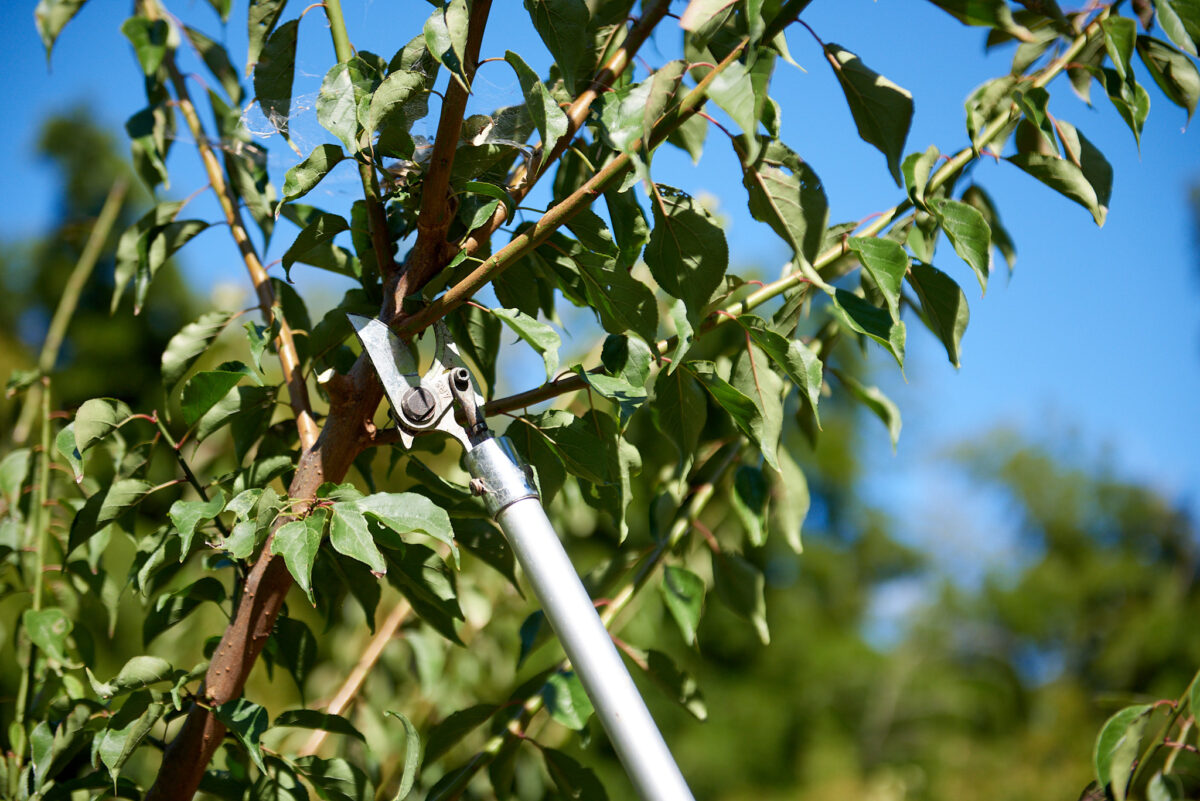
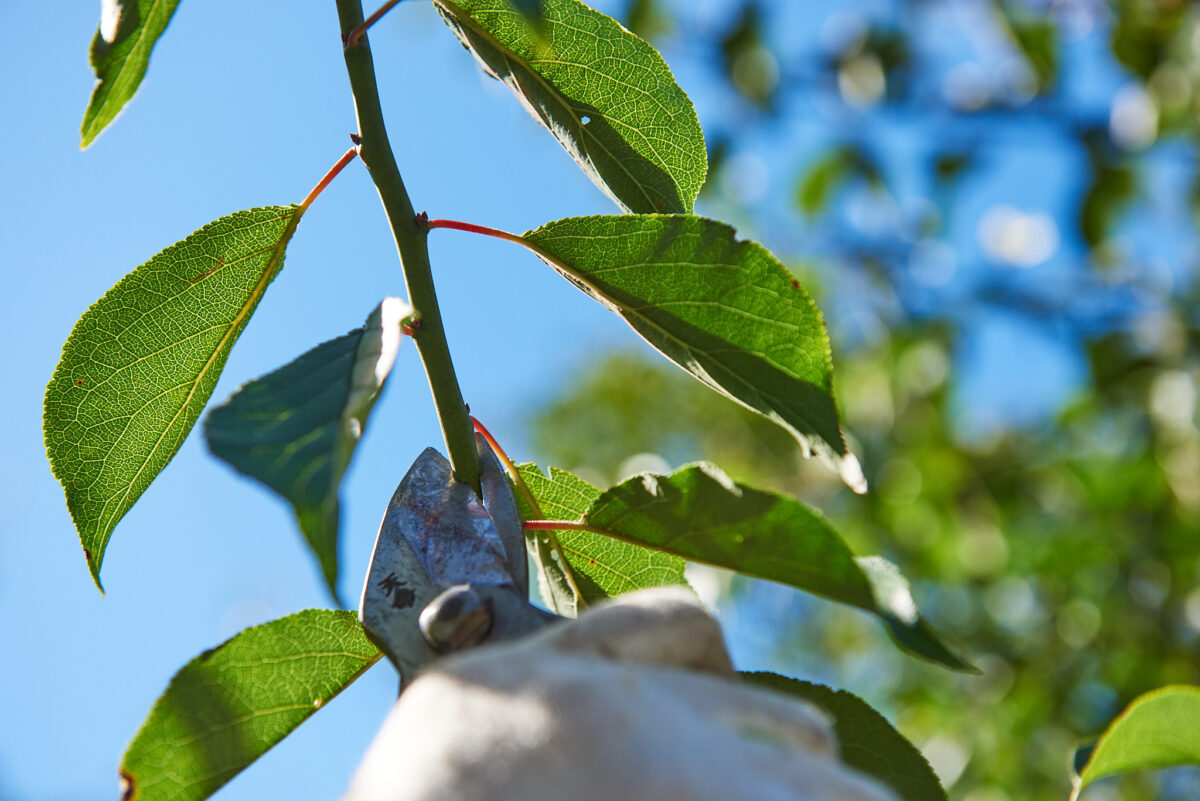
1O月 October
土作り Soil Preparation
- 土作りとは、根の生育を健全にするために、土壌環境を改善する作業です。堆肥を土にほどこすと、有機物の効果で土の粒同士がくっついて、おにぎりのような形になります。これを団粒構造と呼びます。一つ一つの団粒構造の隙間に水や空気、肥料成分が入り込み、 通気力、保水力、保肥力が上がります。この効果で、根の発生が多くなり、樹の生育がよくなることはもちろん、干ばつなどの気象ストレスにも強くなります。
堆肥を播いた土の下にはたくさんの根が発生します。
また、梅は弱酸性土壌を好みます。日本の土壌は、放っておくと酸性が強くなる性質を持っています。このため毎年秋に土壌分析を行い、強酸性に偏っていたら、石灰を施用し、矯正しています。
Soil preparation involves improving the soil environment to ensure healthy root growth. When compost is applied to the soil, the organic matter causes the soil particles to clump together, forming structures similar to rice balls, known as aggregate structures. These aggregates create spaces that allow water, air, and nutrients to penetrate, enhancing the soil’s aeration, water retention, and nutrient-holding capacity. This leads to increased root growth and overall better tree health, making the trees more resilient to weather stresses like drought.
Beneath the compost-treated soil, numerous roots will develop.
Additionally, ume prefers slightly acidic soil. However, Japanese soil tends to become more acidic over time if left unchecked. Therefore, we conduct soil analysis every autumn. If the soil shows a tendency towards strong acidity, we apply lime to correct it.
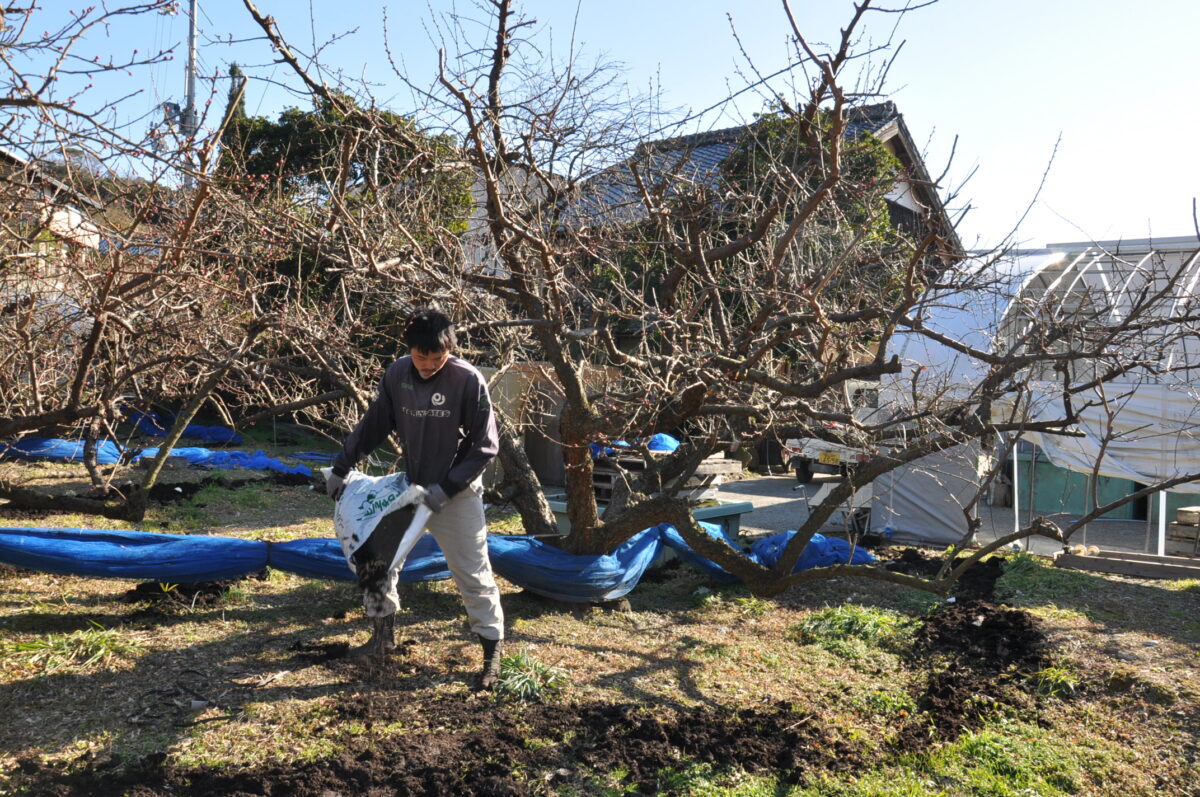
4~5月 April-May
摘心 Pinching
梅の樹には、徒長枝(とちょうし)という、垂直方向に伸びる、太くて長い枝が発生します。
この徒長枝には果実がつきません。そこで徒長枝がまだ細くて短い春に、ハサミで先端を切り落とします。そうすることで、徒長枝が細くなり、果実が着くようになります。
この果実には日が当たりやすく、果実が紅色に着色しやすくなります。紅色の梅は機能性成分が非常に高くなります。
Ume trees develop thick, long branches that grow vertically, known as watersprouts. These watersprouts do not bear fruit. To manage this, we pinch the tips of the watersprouts in spring while they are still thin and short. This pinching process helps thin the watersprouts, enabling them to bear fruit.
The fruit on these pinched branches receives ample sunlight, which helps them develop a red color. Red ume has a higher content of functional components, making them especially valuable.
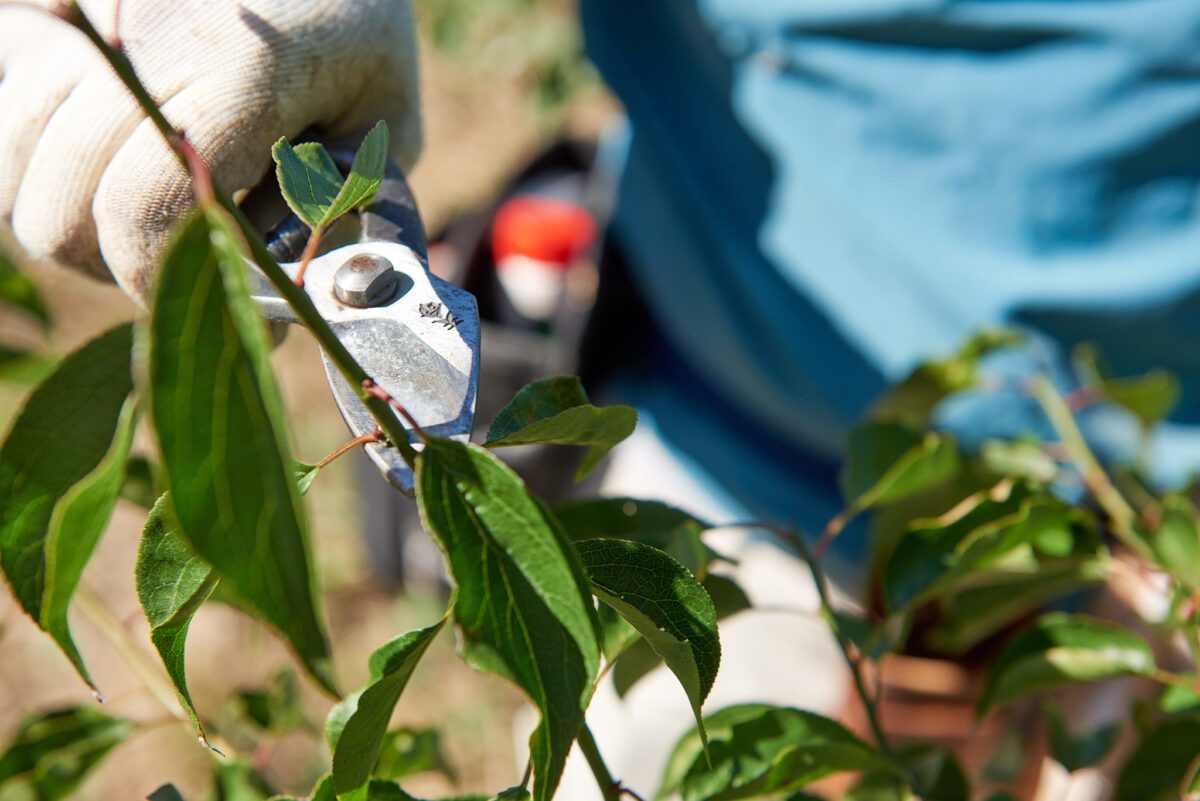
6月 June
収穫 Harvest
梅酒用の果実は、一般には6月中旬頃の緑色の時期に収穫されますが、当園では、少し遅らせて、果実が緑色から黄色に変色し、少し柔らかくなる6月中の2~3日間という、ごく限られた期間に収穫しています。その理由は、この時期の果実は、香りが良くなると同時に、機能性成分量が増加するので、品質の良い梅酒ができるからです。これより早くても、遅くても、風味や機能性成分量が劣ってきます。 その中でも、日当たりの良い位置に着果した果実は、さらに機能性成分が高くなります。当園では、色や硬さを確認しながら日当たりの良い位置に着果した果実のみを、一果ずつ手摘みしています。このような果実を原料にし、風味が良く、機能性が高い梅酒づくりを徹底しています。
梅干し用の果実は、完全に熟して落果するまで待ちます。完熟した果実は、大きくて柔らかくなり、梅干しに最適になります。地面には果実が汚れないように網を敷いています。 こうして収穫した果実の中から傷や汚れのない果実をさらに選別して梅干に加工します。
Generally, fruit for umeshu is harvested when it is green, around mid-June. However, at our farm, we delay the harvest slightly and pick the fruit during a very limited period of 2-3 days in June when the fruit turns from green to yellow and becomes slightly soft. The reason for this timing is that the fruit during this period has a better aroma and an increased amount of functional components, resulting in higher-quality umeshu. Harvesting either earlier or later than this period results in inferior flavor and functional component levels.
Furthermore, fruit that has grown in well-sunlit positions contains even higher levels of functional components. At our farm, we meticulously hand-pick each fruit, selecting only those that are in sunlit positions and have the right color and firmness. By using such carefully selected fruit, we ensure the production of umeshu with excellent flavor and high functionality.
For umeboshi, we wait until the fruit is fully ripe and falls naturally. Fully ripened fruit becomes large and soft, making it ideal for umeboshi. We lay nets on the ground to prevent the fruit from getting damaged. After harvesting, we further select only the unblemished and clean fruit for processing into umeboshi.
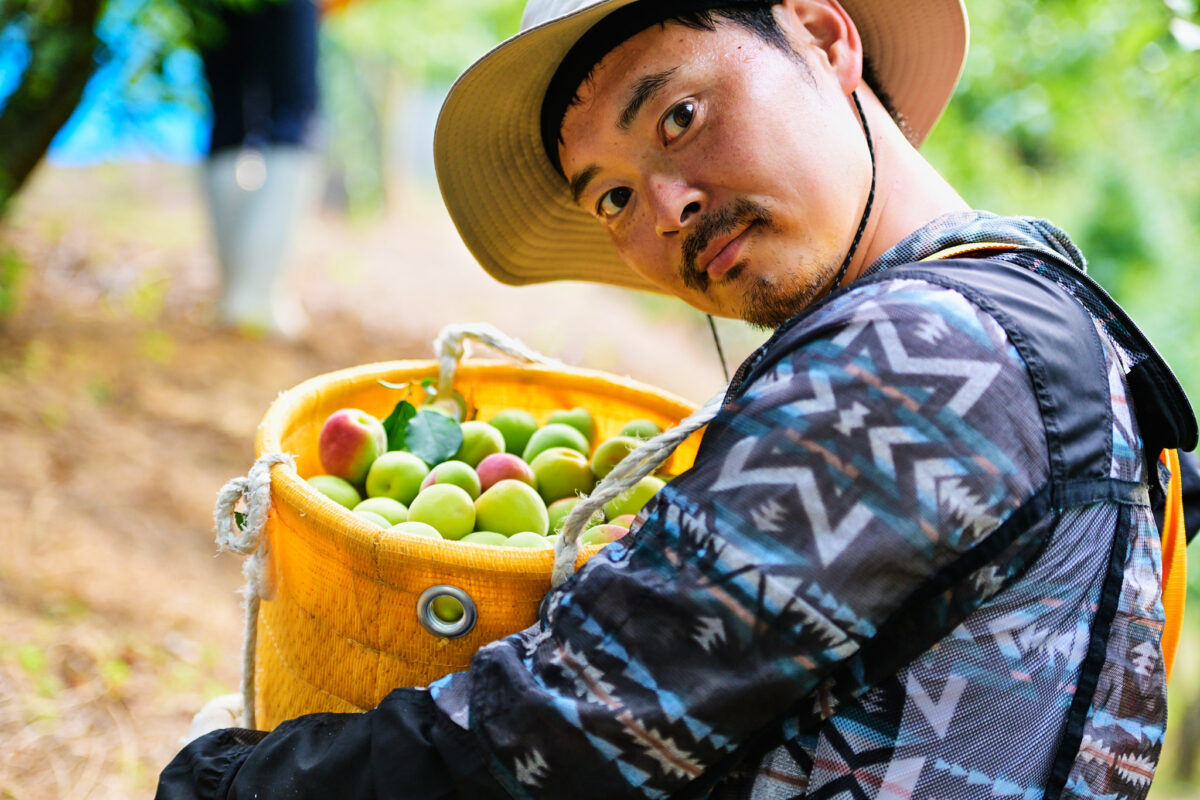
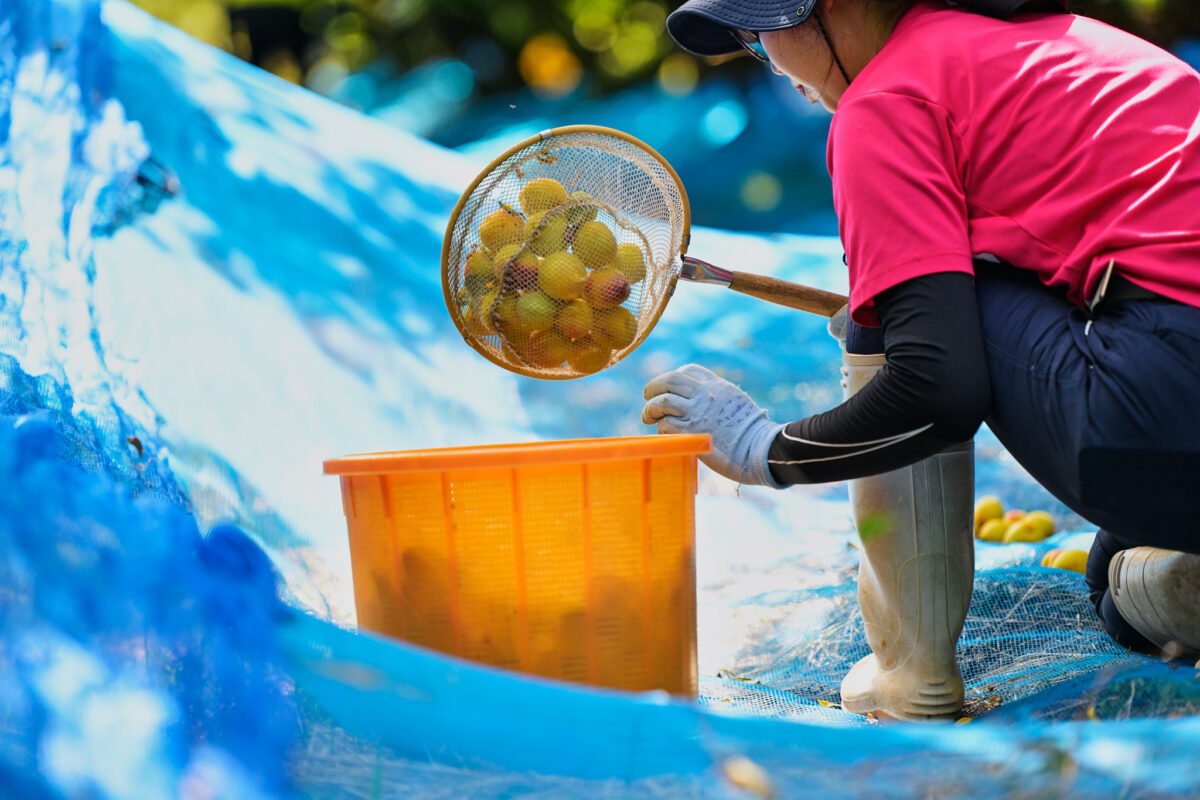
4~5月 April-May
肥料 Fertilizing
樹は、果実を着けることによって体力を消耗します。そのため、窒素、カリウム、リン酸などのミネラル分を補給する必要があります。 そこで、春、収穫中、秋の年3回、肥料をやっています。春は果実の生育を促すため、収穫中は着果による疲れを直ちに回復するため、秋は来年の生育のためにミネラル分を貯蔵させるために行います。
Bearing fruit consumes the tree’s energy. Therefore, it is necessary to replenish minerals such as nitrogen, potassium, and phosphoric acid. We fertilize the trees three times a year: in spring, during the harvest, and in autumn. In spring, fertilization promotes fruit growth; during the harvest, it helps the tree recover quickly from the strain of fruit-bearing; and in autumn, it allows the tree to store minerals for the next year’s growth.
7月~9月 July-September
水やり Watering
収穫後、梅雨が明けたら梅の樹は、早速来年の生育のための養分を蓄えるステージに入ります。しかし、夏に入ると、気温が上がり、雨も少なくなります。樹が乾燥すると、葉の光合成作用が低くなり、葉で作られる養分量も少なくなります。そこで、晴れの日が続くと、水やりを行います。 スプリンクラーを設置している園は、場所によって水やり時間帯が決められていて、夜中に行うこともあります。また、スプリンクラーのない園は、10000リットルの水を何回かに分けてタンクで運び、ホースで株元に丁寧に水やりします。大変な重労働ですが、樹の健康を維持するためには非常に重要な作業です。
After the harvest and once the rainy season ends, ume trees enter a stage where they begin storing nutrients for the next year’s growth. However, as summer progresses, temperatures rise and rainfall decreases. If the trees become too dry, the photosynthesis activity of the leaves diminishes, reducing the amount of nutrients produced. Therefore, we water the trees during extended periods of sunny weather.
In orchards equipped with sprinklers, watering schedules are set based on the location, and watering can sometimes be done at night. For orchards without sprinklers, we transport 10,000 liters of water in tanks, making several trips, and carefully water the base of each tree using hoses. Although it requires a lot of time and work, it is crucial for maintaining the health of the trees.
